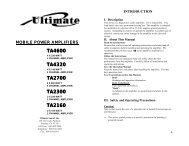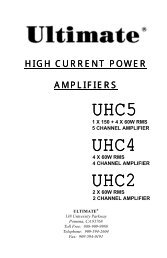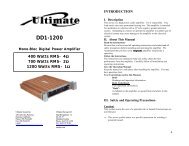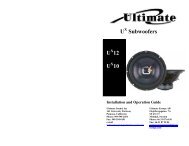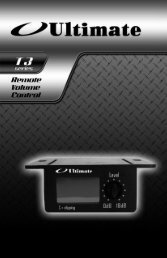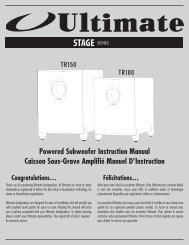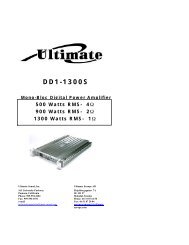T2-Series - Ultimate Sound
T2-Series - Ultimate Sound
T2-Series - Ultimate Sound
Create successful ePaper yourself
Turn your PDF publications into a flip-book with our unique Google optimized e-Paper software.
Installation<br />
<strong>Ultimate</strong> recommends professional installation of all it’s products. Should you choose to install this product<br />
yourself, please read this manual carefully and refer to the instructions detailed below. Failure to do so may<br />
result in poor product performance, premature or immediate malfunction, and potential damage to your<br />
vehicle or it’s contents.<br />
• When selecting a location to mount your amplifier, please ensure proper ventilation is considered. Areas<br />
below seats or in trunks are suitable, so long as air flow is not restricted. Refrain from mounting your<br />
amplifier upside down, as heat will not dissipate effectively, and can result in thermal shutdown or<br />
component failure<br />
• Using a standard Allen key (3/32), remove the hex bolts located in the fins at the top of the amplifier heat<br />
sink. Pulling the end caps away from the amp, you’ll find all the connectors and adjustments to complete<br />
the installation.<br />
• Mount your amplifier using 4 screws, preferably onto a piece of wood. If screwing into the body of the<br />
vehicle, be sure to check for brake, fuel or electrical lines, as well as stay clear of the gas tank.<br />
• Using a minimum of 8 gauge wire, run a power cable directly to the positive terminal of your battery to<br />
the ‘+12V’ terminal of your amp. A separate fuse must be located within 18 inches of the battery to protect<br />
the vehicle from a potential short. Total up the fuse ratings on your amplifiers to determine the fuse size<br />
required under the hood.<br />
• Your amplifier will turn on only when ignition is activated.This can be accomplished by connecting an 18<br />
gauge wire to the ‘trigger’ output on your head unit. If you are using an OEM radio, this will not be<br />
available. You must locate a +12v switched circuit to achieve this.<br />
• The ground path is equally important to the positive feed of your amplifier. Find or create a bare metal<br />
spot on the vehicle’s chassis. Using as short a wire as possible, connect to the ‘GND’ terminal using the<br />
same gauge wire as you did for power. The paint on the body must be removed to bare metal.<br />
• If you’re using a low-level output signal from your head unit, ensure to use a high quality RCA cable to<br />
prevent unwanted noise. It is preferred to use the side opposite to the power wire to run the RCA. Failure to<br />
do so can introduce unwanted noise into the input signal which will be heard through your speakers.<br />
• If your head unit doesn’t have RCA, then the hi-level input of the amp would be used. For this, it is ideal to<br />
tap in on the speakers closest to the amplifier location. Using regular 18 gauge speaker wire, take left and<br />
right (both positive and negative) signals. Connect directly to the ‘hi-level’ input on your amplifier. Proper<br />
gain settings are required to ensure undistorted sound.<br />
• You have now completed the basic installation portion of your new amplifier. Please continue to the<br />
“Amplifier Settings” section of this manual to properly configure your amp for maximum listening pleasure.<br />
6



